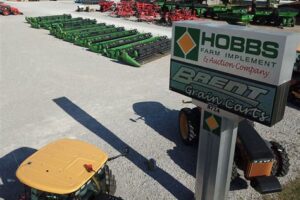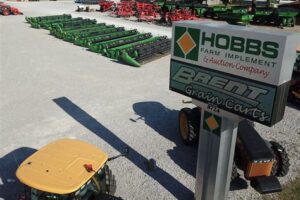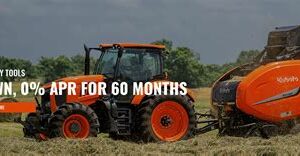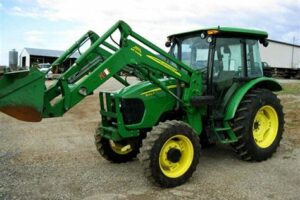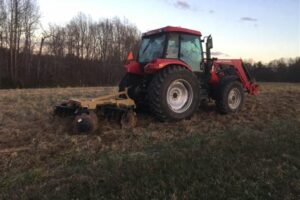Table of Contents
Common farm equipment refers to the tools and machinery used in agricultural activities such as planting, harvesting, and animal husbandry. This includes tractors, plows, seeders, combines, balers, and milking machines. Understanding and utilizing these essential tools is crucial for successful farming and maximizing productivity on the farm.
When it comes to farming, having the right equipment is crucial to ensure efficiency and productivity. From tractors to harvesters, common farm equipment plays a vital role in modern agriculture. Transitioning from traditional methods to mechanized farming has revolutionized the industry, making it possible to cultivate larger areas of land and meet the demands of a growing population. In this article, we will explore some of the most essential pieces of farm equipment and discuss their significance in enhancing agricultural practices.
Introduction
In the world of agriculture, the use of farm equipment has revolutionized the way farms operate. These tools and machines have made farming more efficient, allowing farmers to maximize their productivity and yield. From tractors to harvesters, there is a wide range of common farm equipment that plays a crucial role in modern-day farming. In this article, we will explore some of these essential tools and their significance in the agricultural industry.
Tractors
Tractors are the backbone of any farm operation. These powerful machines are used for a variety of tasks, from plowing and planting to hauling and harvesting. Equipped with large rear wheels for traction and a powerful engine, tractors provide the necessary power and torque to carry out heavy-duty work on the farm. They often come with attachments such as plows, cultivators, and seeders, allowing farmers to perform different tasks efficiently.
Combine Harvesters
When it comes to harvesting crops, combine harvesters are indispensable. These machines combine the functions of reaping, threshing, and winnowing, making the harvesting process highly efficient. With their wide headers and rotating cutting platforms, combine harvesters can quickly and effectively cut and collect grains such as wheat, corn, and soybeans. They play a vital role in ensuring timely and efficient harvesting, especially for large-scale farms.
Seeders
Seeders are essential farm equipment used for planting seeds in the soil. These machines come in various types, such as broadcast seeders and precision seeders. Broadcast seeders distribute seeds uniformly over a large area, while precision seeders place seeds at specific intervals and depths. Seeders help farmers save time and effort by automating the process of seeding, ensuring accurate and consistent seed placement.
Sprayers
Sprayers are vital tools used for applying fertilizers, herbicides, and pesticides to crops. These machines ensure proper coverage and distribution of agricultural inputs, protecting crops from pests, diseases, and weeds. Sprayers come in different types, including handheld sprayers, backpack sprayers, and tractor-mounted sprayers. They are designed to provide precise application rates and reduce wastage of chemicals, promoting sustainable farming practices.
Plows
Plows have been used in agriculture for centuries and continue to be essential farm equipment. They are used for primary tillage, breaking up the soil and turning it over to prepare it for planting. Plows come in various designs, including moldboard plows, chisel plows, and disc plows. These tools help loosen compacted soil, incorporate organic matter, and bury crop residues, creating a favorable environment for seed germination and root growth.
Balers
Balers are used to compress and bundle agricultural materials such as hay, straw, and silage into compact bales. These bales are then stored or transported easily. Balers come in different types, including round balers and square balers. They help farmers efficiently manage and store large volumes of fodder, ensuring a constant supply of feed for livestock throughout the year. Balers contribute to minimizing wastage and improving the overall efficiency of the farm.
Irrigation Systems
Irrigation systems are vital for providing water to crops when natural rainfall is insufficient. These systems ensure that crops receive the required amount of water at the right time, promoting optimal growth and yield. There are various types of irrigation systems, including sprinkler systems, drip irrigation, and center pivot systems. By automating the watering process, irrigation systems help conserve water and improve water-use efficiency, crucial factors in sustainable agriculture.
Harrows
Harrows are farm implements used for secondary tillage. They are primarily used to break up clods, level the soil, and remove weeds after plowing. Harrows come in different types, such as disc harrows, chain harrows, and spike harrows. These tools help create a fine seedbed, improve soil aeration, and enhance water infiltration. Harrowing is an important step in crop establishment, as it prepares the soil for seeding or planting.
Spreaders
Spreaders are farm equipment used for spreading fertilizers, lime, and other soil amendments evenly across the field. They ensure accurate application rates, preventing over- or under-fertilization, which can negatively impact crop growth. Spreaders come in various types, including broadcast spreaders and drop spreaders. By efficiently distributing nutrients and improving soil fertility, spreaders contribute to optimal crop nutrition and overall yield.
Mowers
Mowers are essential tools for cutting and maintaining grass, hay, and other vegetation on the farm. They come in different types, such as rotary mowers, flail mowers, and sickle bar mowers. Mowers help farmers manage pastureland, produce quality forage for livestock, and maintain a neat and tidy farm appearance. These machines are designed to operate efficiently and provide precise cutting, ensuring optimal regrowth and overall productivity.
Conclusion
The wide range of common farm equipment discussed in this article highlights the importance of mechanization in modern agriculture. These tools and machines have transformed farming practices, increasing efficiency, productivity, and sustainability. From tractors and harvesters to seeders and sprayers, each piece of equipment plays a crucial role in different stages of the farming process. By utilizing these tools effectively, farmers can overcome challenges, maximize yields, and contribute to the global food supply.
Common Farm Equipment
In modern agriculture, tractors are considered the workhorses of the industry. These powerful machines provide farmers with the necessary power and versatility to efficiently carry out a wide range of tasks. Equipped with robust engines and multiple attachments, tractors can plow fields, seed crops, harvest produce, and transport heavy loads, making them indispensable on any farm.
Another essential piece of equipment in farming is the combine harvester. Combining the functions of reaping, threshing, and winnowing, these machines are crucial for efficiently harvesting grain crops. By cutting the crop and separating the grains from the stalks, combine harvesters significantly reduce the time and labor required for this key agricultural task.
Planters and seeders are vital tools for precision crop planting. These equipment accurately place seeds at the desired depth, ensuring optimal seed-to-soil contact. This precise placement enables uniform germination and maximizes the potential yield. By improving planting efficiency, planters and seeders save both time and resources for farmers.
Sprayers play a crucial role in pest and disease control in agriculture. These equipment allow farmers to apply fertilizers, herbicides, and pesticides uniformly, preventing crop damage and promoting healthy plant growth. With precise spraying mechanisms and adjustable nozzles, sprayers help optimize chemical application, reducing waste and environmental impact.
Hay balers are used to efficiently gather, compress, and bind hay into compact bales for storage or transportation. These machines automate the labor-intensive process of baling hay manually, allowing farmers to save time and enhance operational efficiency. Hay balers come in various sizes and types, accommodating different farm sizes and hay production volumes.
Irrigation systems are essential for ensuring adequate water supply to crops. From traditional flood irrigation to more advanced drip and sprinkler systems, these equipment provide controlled water delivery, preventing crop dehydration and enhancing plant growth. Effective irrigation systems help optimize water usage, conserving this precious resource while maximizing crop yields.
Milking machines revolutionized the dairy industry by automating the milking process. These devices efficiently and hygienically extract milk from cows, reducing labor requirements and ensuring consistent milk quality. Milking machines improve milking speed, reduce stress on animals, and allow dairy farmers to increase their herd size, thereby boosting overall productivity.
Grain dryers are crucial for drying harvested grain to prevent spoilage and retain quality. These machines use heated air and forced airflow to reduce the moisture content in crops, optimizing storage conditions. By removing excess moisture, grain dryers improve grain longevity and reduce the risk of mold formation, ensuring farmers can store grains for longer periods without compromising their value.
Conclusion
In conclusion, reliable and efficient farm equipment plays a vital role in modern agriculture. Constant advancements in technology have paved the way for equipment that enhances productivity, reduces labor, and minimizes environmental impact, enabling farmers to meet the increasing demands of a growing population. From tractors and combine harvesters to planters and seeders, sprayers, hay balers, irrigation systems, milking machines, and grain dryers, these common farm equipment are essential tools that contribute to the success and sustainability of agricultural practices.
Point of view: Common Farm Equipment
As a professional in the agricultural industry, I want to emphasize the importance of utilizing common farm equipment to enhance productivity and efficiency on the farm. With advancements in technology and machinery, farmers have access to a wide range of equipment that can greatly simplify their work and maximize their yields. Here are some key points to consider:
- Tractors: Tractors are the backbone of any farm operation. These versatile machines can perform a variety of tasks, from plowing fields to hauling heavy loads. Equipped with various attachments, tractors can also handle tasks such as tilling, planting, and harvesting. By investing in a reliable tractor, farmers can significantly reduce manual labor and complete tasks in a fraction of the time.
- Combine Harvesters: Harvesting crops is one of the most crucial and time-sensitive activities on a farm. Combine harvesters are specifically designed to efficiently harvest and separate grains from the plants. These machines not only save time but also ensure minimal loss and damage to the crops, resulting in higher-quality yields. With their advanced features and cutting-edge technology, combine harvesters have revolutionized the harvesting process for farmers worldwide.
- Irrigation Systems: Water management plays a vital role in successful crop production. Utilizing irrigation systems allows farmers to control the amount and timing of water application, ensuring optimal growth and reducing water wastage. Whether it’s through sprinklers, drip irrigation, or center pivots, these systems enable farmers to maximize crop yields even in areas with limited rainfall.
- Seeders and Planters: Precision is crucial when it comes to planting seeds. Modern seeders and planters offer accurate seed placement, spacing, and depth control, resulting in uniform and consistent crop emergence. These machines enable farmers to cover large areas efficiently while ensuring optimal seed-to-soil contact, ultimately leading to higher germination rates and improved crop establishment.
- Hay Balers: Many farms rely on hay production to feed livestock during the winter months. Hay balers simplify the process of harvesting and baling hay, allowing farmers to efficiently store and transport it. These machines compress the cut hay into compact bales, reducing wastage and preserving the nutritional value. With the help of hay balers, farmers can ensure a steady and sufficient food supply for their animals.
In conclusion, the utilization of common farm equipment is essential for modern agricultural practices. Tractors, combine harvesters, irrigation systems, seeders and planters, and hay balers are just a few examples of the numerous tools available to farmers. By investing in these technologies, farmers can streamline their operations, improve efficiency, and achieve higher yields. Ultimately, embracing the use of common farm equipment is critical for the success and sustainability of any agricultural enterprise.
Thank you for taking the time to visit our blog and learn about common farm equipment. We hope that the information provided has been useful in expanding your knowledge on this important aspect of agriculture. As we conclude this article, we would like to summarize the key points discussed and emphasize the significance of utilizing proper farm equipment for a successful farming operation.
Firstly, we examined the importance of tractors in modern farming. These versatile machines play a crucial role in various agricultural tasks, such as plowing, planting, and harvesting. Their power and efficiency greatly contribute to increasing productivity and reducing labor-intensive processes. By understanding the different types of tractors available, farmers can select the most suitable model for their specific needs, ultimately leading to better outcomes and higher yields.
In addition to tractors, we also explored the significance of other common farm equipment, such as seeders, sprayers, and harvesters. Seeders, for instance, help farmers achieve optimal seed placement, ensuring uniform growth and maximizing crop yield. Sprayers, on the other hand, are essential for pest and weed control, safeguarding crops from potential damage. Lastly, harvesters enable efficient and timely harvesting, minimizing losses and preserving crop quality. By utilizing these tools effectively, farmers can significantly enhance their overall farming operations.
It is crucial to note that investing in high-quality farm equipment is not only beneficial for productivity but also for the safety of farmers. Modern equipment often incorporates advanced features, such as operator protection systems and ergonomic designs, to minimize the risk of accidents and injuries. Therefore, it is essential for farmers to prioritize the maintenance and regular inspection of their equipment to ensure optimal performance and safety.
In conclusion, common farm equipment, including tractors, seeders, sprayers, and harvesters, plays a vital role in modern agriculture. These tools not only increase productivity and efficiency but also contribute to the overall safety of farmers. By understanding the various types of equipment available and their respective uses, farmers can make informed decisions when selecting the most suitable machinery for their farming operations. We hope that this article has provided valuable insights, and we encourage you to continue exploring our blog for more informative content on agriculture and related topics.
Thank you once again for visiting, and we look forward to sharing more knowledge with you in the future. Happy farming!
Video Common Farm Equipment
1. What are some common types of farm equipment?
- Tractors
- Plows
- Harvesters
- Seeders
- Sprayers
- Balers
- Cultivators
- Spreaders
- Mowers
- Combines
2. How do tractors help in farming?
Tractors are versatile farm vehicles that provide power to various farming implements. They enable farmers to perform tasks such as plowing, tilling, planting, and harvesting more efficiently. Tractors can be equipped with different attachments based on the specific needs of the farm operation, making them an essential tool for modern agriculture.
3. What is the purpose of a combine harvester?
A combine harvester, also known as a combine, is a farm machine used for harvesting grains such as wheat, corn, and soybeans. It combines several operations into one, including cutting the crop, threshing (separating the grain from the stalk), and cleaning the grain. Combines significantly reduce the time and labor required for harvesting, making it a vital piece of equipment for large-scale grain production.
4. How do seeders work?
Seeders are farm implements designed to plant seeds in the soil. They typically consist of a hopper that holds the seeds and mechanisms to meter and distribute them evenly. Some seeders also incorporate fertilizer application systems. The seeders are attached to tractors and pulled across the field, allowing for efficient and precise seed placement, which promotes optimal crop growth.
5. Why are sprayers important in farming?
Sprayers are used in farming to apply pesticides, herbicides, and fertilizers to crops. They help control pests, diseases, and weeds that can negatively impact crop yield and quality. Sprayers ensure that the chemicals are evenly distributed over the plants, maximizing their effectiveness while minimizing waste. This contributes to higher crop productivity and healthier plants.
6. What is the role of cultivators in agriculture?
Cultivators are farm implements used to mechanically loosen and aerate the soil, remove weeds, and break up clods after plowing. They help prepare the seedbed for planting and improve soil structure, allowing better water penetration and nutrient absorption by the crops. Cultivators also assist in weed control by uprooting or burying them, reducing competition for resources.
7. How do balers work?
Balers are machines used to compress and bundle agricultural materials such as hay, straw, or silage into compact, manageable bales. They collect the material from the field, compress it using a system of rollers and belts, and tie it with twine or wire to secure the bale. Balers facilitate storage, transport, and feeding of forage materials, enabling efficient livestock management and feeding practices.
8. What are some safety precautions when using farm equipment?
- Read and follow the manufacturer’s instructions for operating the equipment.
- Wear appropriate personal protective equipment (PPE) such as helmets, goggles, gloves, and safety boots.
- Maintain a safe distance from moving parts and keep bystanders away from the operating area.
- Regularly inspect and maintain the equipment to ensure proper functioning.
- Operate machinery on stable and level ground to minimize the risk of overturning.
- Never operate equipment while under the influence of drugs or alcohol.
- Be cautious of overhead power lines and other potential hazards in the vicinity.
- Take breaks and rest when needed to avoid fatigue, which can impair judgment and reaction time.
- Receive proper training on the safe operation of specific farm equipment.
- Keep emergency contact information readily available in case of accidents or emergencies.

